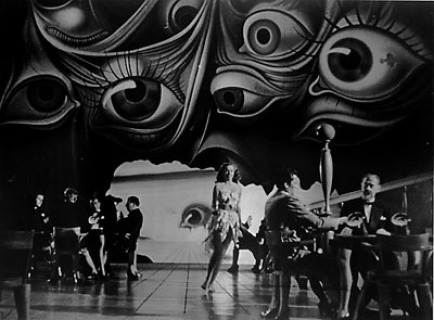I might have thought that an Alfred Hitchcock movie with a psychological twist, Ingrid Bergman, Salvador Dali set pieces and skiing would’ve blown me away, so when I notice how campy, absurd and overacted “Spellbound” is, I may be expected to be frustrated rather than admitting how much fun I had watching the damn thing.
It’s certainly far from a trash, B-movie. It was nominated for Best Picture, Best Director and a handful of other Oscars, and Hitchcock is such a technical perfectionist that it’s impossible not to be entranced in a story even as bananas as this.
Bergman plays Constance Peterson, a bookish psychoanalyst treating patients with guilt complexes and living a life free of love. Bergman is really too beautiful to be convincing as a doctor, but who cares really? She ends up infatuated with the new Dr. Anthony Edwardes (Gregory Peck), but he turns out to be an imposter with a guilt complex of his own. Everyone suspects that this nameless imposter with amnesia killed the real doctor and is burying his guilt in this fabricated lie, but only Constance suspects he is good at heart and could never have killed a man.
Try as the film might, it’s elaborate psychobabble never reaches the profound mind-bending level of “Vertigo,” opting instead for silly moments when Peck shudders in psychological torment as he looks at a white bathtub or the fabric on Bergman’s robe. Her revelation about his suppressed memory leads them to a ski hill in yet another dopey moving background moment, and there are a few more little cinematic tricks that have aged just as badly.
But everything Hitch does is still fine-tuned. The economy in his storytelling can not be denied, and the meticulous geometric precision within which he arranges each shot gives “Spellbound” a definitive mark of greatness.
Bergman is great, becoming believable even when she’s bawling her eyes out at the most melodramatic moments. And Peck is something of a surprise. “Spellbound” was only his fourth film at the time, and although he’s not what you would call “good,” he was a movie star in the making.
But the real reason “Spellbound” is both famous and memorable is the dream sequence constructed from Salvador Dali’s mind. Hitch admired Dali’s work and felt he understood dreams more than anyone at the time, so the pair together constructed a few elaborate sets for what ultimately is a very short but striking few frames. Hitchcock ends up using the many symbols in the story to suggest the film’s final twist, but it’s all so ridiculous that it’s more fun to look at it as the surrealist chaos that it is and have fun with it.
Actually, that’s the best way to watch all of “Spellbound.”


1 thought on “Rapid Response: Spellbound (1945)”